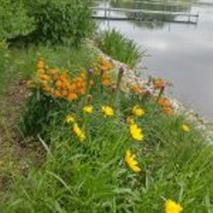Last year, I posted about a new perennial plug planting I did in June of 2016. In that post, Planting Plugs is a Cheap and Easy Way to Plant a Landscape, I showed how a 300 sq ft perennial bed could be prepared and planted using less work and money.
Here was my design for the bed:

Perennial Plug Planting Design
Preparing the planting bed for perennial plugs
“NOTE: if you are the type that wants to dig out your grass and haul away the best 3 inches of your soil, then bring in and spread topsoil full of all kinds of weed seeds, skip ahead to the next section.
First, I killed the grass using an aquatic safe version of glyphosate, Aquaneat, as I live on a lake and know regular formulations of glyphosate are a no no for use near water.
Yes, it is a chemical I would prefer to not use, but with proper precautions it can be used safely. I feel using glyphosate once or twice in an area to prepare a bed and then never having to use it again is a viable option.
My much bigger concern is the insane amounts of this chemical that are applied to Roundup™ ready corn, soybeans and other crops. We won’t be eating the grass we kill with glyphosate.
By the way, if you are eating most any food that is not GMO Free(Genetically Modified organism), you are eating food made with crops sprayed with glyphosate. Yuck!
There are other ways of killing grass, such as sheet composting and solarization, which I have also used. These can be just as effective, but take longer and more planning. Here is a good explanation of one method. There are also some organic sprays (mostly clove and citrus oil) that have promise (more on that in a future post).
Here is what it looked like after the grass was killed:

Planting the garden
I then planted it using plugs, a ProPlugger™ and forced child labor.


A week or so after it was planted a bit of composted was added as mulch and it looked like this:

So what does this perennial plug planting look like one year later?
Since I did know that I would not have a lot blooming in this bed in the Spring, I did add a bunch of (non native) Purple Sensation Allium bulbs in the Fall of last year.
I am glad I did, because I had something happening this Spring before June. Here is what they looked like in May.

Those little Blue Flag Iris plugs Catherine planted less than a year earlier in the shoreline below this bed looked great in bloom this Spring.
Here is what they looked like in June of last year:

And here they are this May:

Here is a shot of my Sand or it’s other name, Lance-leaf Coreopsis (Coreopsis lanceolata) in bloom with Allium seed heads on June 7th.


In late June the garden is in full swing.
The green Prairie Dropseed mounds are starting to fill in, the purple Liatris are beginning their bloom, the yellow Coreopsis are ending their first flush of blooms, and the Orange Butterfly weed are supplying the fireworks.


In Late June the Swamp Milkweed are also starting to bloom.
Tweaking the garden
Now that I have seen this garden for 12 months, I have some problems/ideas on how to improve my perennial plug planting going forward.
Butterfly Weed leaves big holes in the garden in Spring
While I did know that Butterfly weed was late waking up in the Spring, I forgot just how REALLY slow they are coming up. Since I planted almost a full flat (32) of these in my yard and a lot of those is this bed, there was some serious voids in the Spring.
So what do I do about it?
Every problem is a potential opportunity in the garden.
My solution is to plant some Spring ephemerals in those voids. These are plants that will come up early and then die to the ground in the Summer just as my Butterfly weed get growing.
There are lots of choices here, but I am partial to two for this spot. The first is Shootingstar (Dodecatheon meadia)which is a prairie ephemeral and fits in perfectly with this planting. I actually had planned to do this last year, but never got around to it.
The second is Virginia Bluebells (Mertensia virginica), a favorite of mine. Virginia Bluebells would not normally be associated with the sun loving Butterfly weed, but may work very nicely in parts of the bed with a bit of the shade.

I am too impatient for seeds, so I will get some bare root Shooting Stars and Virginia Bluebells. Spring blooming perennials are best planted in the fall. This gives the roots time to establish, and allows the plants a strong start the following spring.
The resulting blooms will not only help fill out the bare spots for slow emerging Butterfly weed, but will also benefit early season pollinators, as well.
A shorter Goldenrod is not so short in May
I also found that my Little Lemon Goldenrod get full size real quick, unlike my Asters (another Fall bloomer) that stays small to later in the season. I may move them around to a spot a bit further back in the garden so their relatively tall Spring height will look more in place.


